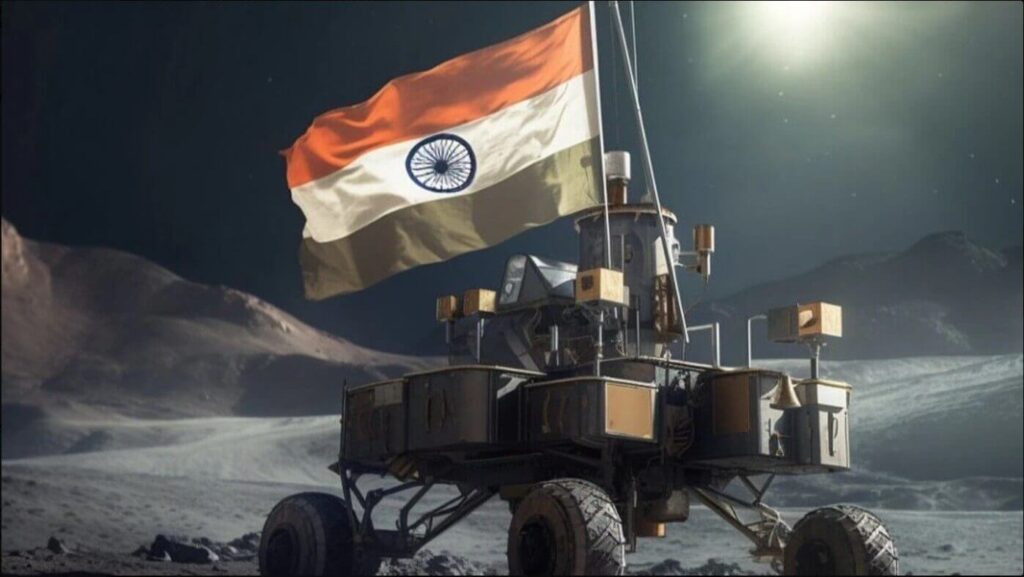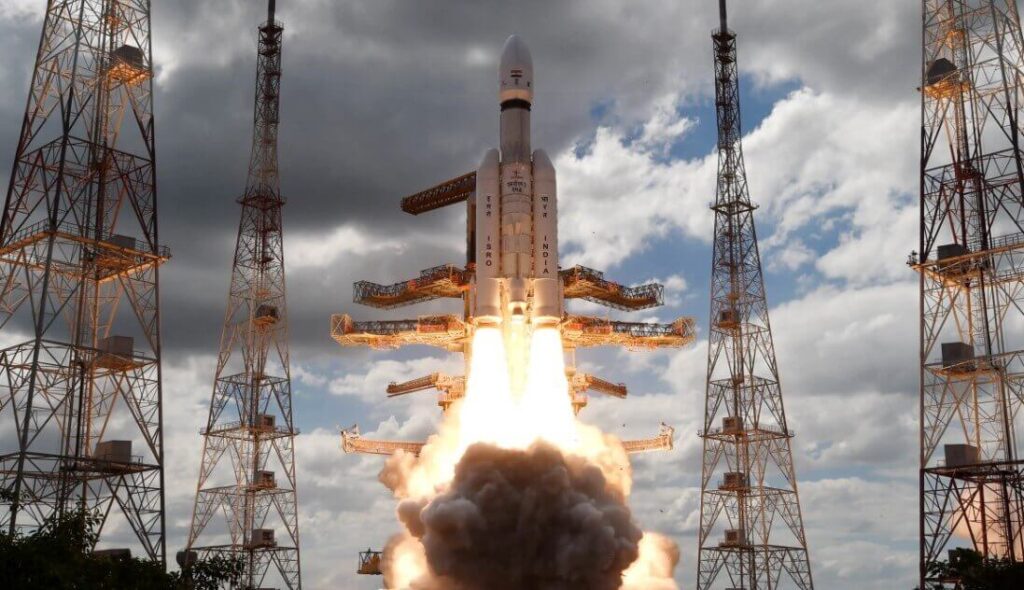Chandrayaan-3 : How AI Boosted ISRO’s Mission to Success for India

Chandrayaan-3 is on its journey to the moon
In the realm of space exploration, Artificial Intelligence (AI) has emerged as a pivotal asset, reshaping the way missions are executed. With its ability to swiftly analyze data, predict outcomes, and enable autonomous operations, AI has now found its way into the heart of endeavors like the Chandrayaan-3 lunar mission. This integration has not only streamlined operations but has also proven instrumental in ensuring a secure lunar landing.
At the forefront of Chandrayaan-3’s achievements is the incorporation of AI-powered sensors. These sensors played a vital role in orchestrating a flawless touchdown on the lunar surface. Their capabilities extended to predicting the intricate lunar topography, identifying potential obstacles, and most impressively, guiding the lander through its descent with remarkable precision, thereby mitigating potential risks.
One of the standout technological innovations, unveiled by ISRO chairman S Somnath, involved an array of sophisticated instruments including velocimetres and altimeters. These devices collectively delivered crucial real-time information concerning the lander’s speed and altitude, enhancing the control and accuracy of the mission.
A key aspect of this triumph was the assortment of strategically positioned cameras. These cameras were engineered to serve distinct purposes, such as hazard avoidance and inertia-based imaging. Their synchronized operation culminated in a treasure trove of essential images that were meticulously amalgamated using advanced computer algorithms. The result? A comprehensive and highly detailed visual representation that precisely identified the lander’s exact location on the lunar surface.
Chandrayaan-3’s success story serves as a shining testament to the transformative potential of AI in the realm of space exploration. Beyond its technical contributions, AI has fundamentally altered the scope of what’s achievable, ushering in an era where complex missions can be undertaken with heightened accuracy and reduced uncertainty. As AI continues to evolve, it’s certain that its partnership with space exploration will only grow stronger, promising even more remarkable feats on the horizon.
In the Lander’s arsenal of advanced technologies to accomplish its mission objectives, we find:

- Altimeters: The Lander is equipped with cutting-edge altimeters that operate using both laser and radio frequency (RF) technology. These instruments precisely measure the distance between the Lander and the lunar surface, aiding in safe and accurate landing.
- Velocimeters: Enhancing landing precision, the Lander is armed with two types of velocimeters. The first is a Laser Doppler Velocimeter, which gauges the Lander’s velocity by analyzing laser light reflections. The second is the Lander Horizontal Velocity Camera, which captures real-time images to ascertain horizontal movement. Chandrayaan-3
- Inertial Measurement: The Lander boasts an advanced inertial measurement system based on laser gyro technology. This system not only provides crucial referencing data but also incorporates accelerometers to gauge acceleration, enabling precise navigation.
- Propulsion System: Powering the Lander’s maneuverability are sophisticated propulsion systems. These include an 800N throttleable liquid engine for main propulsion, 58N attitude thrusters for orientation adjustments, and an electronic control unit to regulate the throttleable engine’s performance.
- Navigation, Guidance & Control (NGC): The Lander’s trajectory during powered descent is masterfully designed, with associated software elements governing its course. This NGC system ensures the Lander’s controlled descent and accurate placement on the lunar surface.
- Hazard Detection and Avoidance: The Lander’s safety is bolstered by its hazard detection and avoidance capabilities. This includes specialized cameras equipped to identify potential risks during descent. These cameras feed data into advanced processing algorithms, allowing the Lander to make informed decisions to steer clear of hazards.
- Landing Leg Mechanism: Vital to the mission’s success is the Lander’s landing leg mechanism. This intricate system supports the Lander’s weight during touchdown, absorbing impact forces and ensuring a stable and secure landing. Chandrayaan-3
In essence, the Lander is a marvel of modern engineering, incorporating an array of cutting-edge technologies including altimeters, velocimeters, inertial measurement systems, propulsion systems, navigation and guidance software, hazard detection and avoidance systems, and a robust landing leg mechanism. Together, these technologies synergize to enable a safe, controlled, and successful lunar landing, pushing the boundaries of what’s achievable in space exploration.
Pioneering the Future: AI and Machine Learning’s Role in Chandrayaan-3 and Beyond

In the expansive saga of human accomplishments, the realm of space exploration stands as a testament to our unyielding curiosity and boundless quest for knowledge. In this era of technological advancement, the convergence of Artificial Intelligence (AI) and Machine Learning (ML) emerges as the unsung hero propelling space endeavors like Chandrayaan-3 to unparalleled triumphs. Their prowess in data analysis, predictive modeling, autonomous decision-making, and more has fundamentally revolutionized how we conceive, implement, and interpret space missions, ushering in an era of heightened efficiency and precision.
Unlocking the Potential of Data Analysis and Prediction
Central to any space project is an ocean of data gleaned from diverse sensors, instruments, and spacecraft components. Yet, the true worth of this data is extracted through its effective analysis. Enter AI, with its capacity to swiftly process colossal datasets. Chandrayaan-3, India’s trailblazing lunar mission, confronted copious data pertaining to lunar landscapes, spacecraft telemetry, and environmental variables. By employing advanced AI algorithms, scientists could analyze this data in near real-time, unearthing insights pivotal for informed decision-making during pivotal mission phases.
Predictive modeling is another realm where AI shines. ML algorithms, trained on historical data, can forecast potential anomalies, malfunctions, or shifts in the environment. In Chandrayaan-3, this facet played a pivotal role in ensuring spacecraft safety. By preemptively identifying potential issues, engineers could proactively mitigate them, curtailing risks and amplifying mission success. Chandrayaan-3
The Choreography of Autonomous Navigation and Decision-Making
Navigating through space is a delicate interplay of precision and unpredictability. AI-powered autonomous navigation enhances a spacecraft’s adaptability to evolving conditions and unforeseen obstructions. In Chandrayaan-3, navigation algorithms fueled by AI empowered the spacecraft to modify its course on-the-fly, informed by real-time data analysis. This dynamic decision-making curtailed the dependence on ground control and enabled the spacecraft to deftly respond to dynamic situations.
Optimized Resource Management: The Art of Efficiency
Space missions often demand judicious resource management, where efficient allocation can substantially influence mission outcomes. AI plays a decisive role in this realm, optimizing the allocation of resources from fuel consumption to power distribution. AI algorithms scrutinize current consumption trends and project future requirements, facilitating the optimal allocation of limited resources. This facet proved indispensable in Chandrayaan-3’s lunar odyssey, where each unit of fuel and energy held profound significance.
Illuminating Scientific Revelations
The scientific voyage of space missions hinges upon accurate and swift interpretation of gathered data. AI-fueled data analysis expedites the extraction of meaningful insights from raw information. In Chandrayaan-3, AI-driven analysis of images and spectral data expedited the identification of intriguing geological features, contributing to groundbreaking revelations about the moon’s composition and history. The accelerated data processing ensured that scientific breakthroughs weren’t impeded by cumbersome manual analysis.
Navigating Communication Challenges with AI
Communication between Earth and spacecraft can encounter latency due to vast distances, posing quandaries when real-time decisions are necessitated. AI offers a solution by enabling autonomous onboard decision-making. In scenarios where direct communication with ground control isn’t feasible, AI-equipped systems onboard can enact critical decisions based on pre-defined algorithms. During Chandrayaan-3’s descent, its lander, akin to its predecessor, harnessed AI-empowered hazard detection and avoidance systems, autonomously evaluating and responding to potentially hazardous conditions.
Charting the Path Forward: AI and the Evolution of Space Exploration

As we gaze into the future, the symbiotic relationship between AI and space exploration is poised to deepen. From facilitating swifter and safer interplanetary journeys to shaping the landscape of advanced robotics for extraterrestrial exploration, AI’s promise knows no bounds. Collaborative endeavors between AI experts, space scientists, and engineers will persist in pushing the boundaries of what’s attainable.
In summation, Chandrayaan-3 stands as a testament to the transformative potency of AI and ML in space endeavors. Their roles encompass data analysis, predictive modeling, autonomous navigation, resource optimization, scientific revelation, and surmounting communication challenges. With every triumphant mission, the alliance between AI and space exploration grows more steadfast, propelling humanity towards new thresholds of wisdom and discovery. As technology evolves and AI capabilities burgeon, the cosmos awaits our next monumental leap, driven by the intellect of our own creation.





Leave a Reply